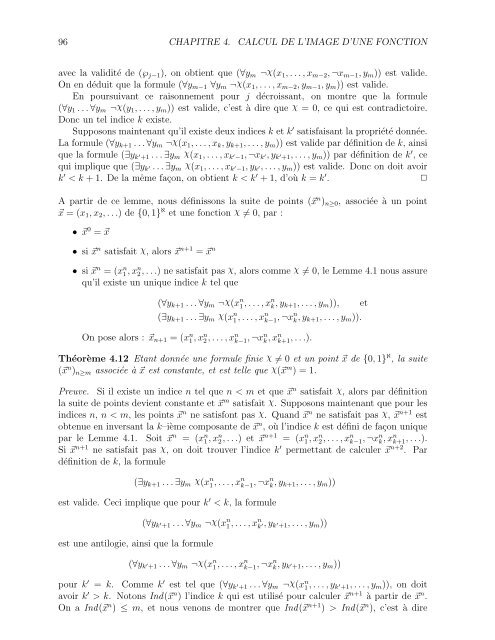Une Boite `a Outils Pour la Preuve Formelle de Syst`emes Séquentiels
Une Boite `a Outils Pour la Preuve Formelle de Syst`emes Séquentiels
Une Boite `a Outils Pour la Preuve Formelle de Syst`emes Séquentiels
Create successful ePaper yourself
Turn your PDF publications into a flip-book with our unique Google optimized e-Paper software.
96 CHAPITRE 4. CALCUL DE L’IMAGE D’UNE FONCTION<br />
avec <strong>la</strong> validité <strong>de</strong> (℘ j−1 ), on obtient que (∀y m ¬χ(x 1 ,...,x m−2 ,¬x m−1 ,y m )) est vali<strong>de</strong>.<br />
On en déduit que <strong>la</strong> formule (∀y m−1 ∀y m ¬χ(x 1 ,...,x m−2 ,y m−1 ,y m )) est vali<strong>de</strong>.<br />
En poursuivant ce raisonnement pour j décroissant, on montre que <strong>la</strong> formule<br />
(∀y 1 ...∀y m ¬χ(y 1 ,...,y m )) est vali<strong>de</strong>, c’est à dire que χ = 0, ce qui est contradictoire.<br />
Donc un tel indice k existe.<br />
Supposons maintenant qu’il existe <strong>de</strong>ux indices k et k ′ satisfaisant <strong>la</strong> propriété donnée.<br />
La formule (∀y k+1 ...∀y m ¬χ(x 1 ,...,x k ,y k+1 ,...,y m )) est vali<strong>de</strong> par définition <strong>de</strong> k, ainsi<br />
que <strong>la</strong> formule (∃y k ′ +1...∃y m<br />
χ(x 1 ,...,x k ′ −1,¬x k ′,y k ′ +1,...,y m )) par définition <strong>de</strong> k ′ , ce<br />
qui implique que (∃y k ′...∃y m<br />
χ(x 1 ,...,x k ′ −1,y k ′,...,y m )) est vali<strong>de</strong>. Donc on doit avoir<br />
k ′ < k +1. De <strong>la</strong> même façon, on obtient k < k ′ +1, d’où k = k ′ . ✷<br />
A partir <strong>de</strong> ce lemme, nous définissons <strong>la</strong> suite <strong>de</strong> points (⃗x n ) n≥0 , associée à un point<br />
⃗x = (x 1 ,x 2 ,...) <strong>de</strong> {0,1} ℵ et une fonction χ ≠ 0, par :<br />
• ⃗x 0 = ⃗x<br />
• si ⃗x n satisfait χ, alors ⃗x n+1 = ⃗x n<br />
• si ⃗x n = (x n 1,x n 2,...) ne satisfait pas χ, alors comme χ ≠ 0, le Lemme 4.1 nous assure<br />
qu’il existe un unique indice k tel que<br />
(∀y k+1 ...∀y m ¬χ(x n 1,...,x n k,y k+1 ,...,y m )),<br />
(∃y k+1 ...∃y m<br />
χ(x n 1,...,x n k−1,¬x n k,y k+1 ,...,y m )).<br />
On pose alors : ⃗x n+1 = (x n 1,x n 2,...,x n k−1,¬x n k,x n k+1,...).<br />
Théorème 4.12 Etant donnée une formule finie χ ≠ 0 et un point ⃗x <strong>de</strong> {0,1} ℵ , <strong>la</strong> suite<br />
(⃗x n ) n≥m associée à ⃗x est constante, et est telle que χ(⃗x m ) = 1.<br />
<strong>Preuve</strong>. Si il existe un indice n tel que n < m et que ⃗x n satisfait χ, alors par définition<br />
<strong>la</strong> suite <strong>de</strong> points <strong>de</strong>vient constante et ⃗x m satisfait χ. Supposons maintenant que pour les<br />
indices n, n < m, les points ⃗x n ne satisfont pas χ. Quand ⃗x n ne satisfait pas χ, ⃗x n+1 est<br />
obtenue en inversant <strong>la</strong> k–ième composante <strong>de</strong> ⃗x n , où l’indice k est défini <strong>de</strong> façon unique<br />
par le Lemme 4.1. Soit ⃗x n = (x n 1,x n 2,...) et ⃗x n+1 = (x n 1,x n 2,...,x n k−1,¬x n k,x n k+1,...).<br />
Si ⃗x n+1 ne satisfait pas χ, on doit trouver l’indice k ′ permettant <strong>de</strong> calculer ⃗x n+2 . Par<br />
définition <strong>de</strong> k, <strong>la</strong> formule<br />
(∃y k+1 ...∃y m<br />
χ(x n 1,...,x n k−1,¬x n k,y k+1 ,...,y m ))<br />
est vali<strong>de</strong>. Ceci implique que pour k ′ < k, <strong>la</strong> formule<br />
est une antilogie, ainsi que <strong>la</strong> formule<br />
(∀y k ′ +1...∀y m ¬χ(x n 1,...,x n k ′,y k ′ +1,...,y m ))<br />
(∀y k ′ +1...∀y m ¬χ(x n 1,...,x n k−1,¬x n k,y k ′ +1,...,y m ))<br />
pour k ′ = k. Comme k ′ est tel que (∀y k ′ +1...∀y m ¬χ(x n 1,...,y k ′ +1,...,y m )), on doit<br />
avoir k ′ > k. Notons Ind(⃗x n ) l’indice k qui est utilisé pour calculer ⃗x n+1 à partir <strong>de</strong> ⃗x n .<br />
On a Ind(⃗x n ) ≤ m, et nous venons <strong>de</strong> montrer que Ind(⃗x n+1 ) > Ind(⃗x n ), c’est à dire<br />
et


